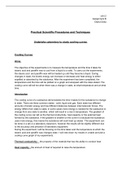Unit 2
Assignment B
Diana Duka
Practical Scientific Procedures and Techniques
Undertake calormtery to study cooling curves
Cooling Curves
Aims
The objective of the experiments is to measure the temperature and the time it takes for
stearic acid and paraffin wax to cool from a liquid to a solid. To carry out the experiments,
the stearic acid and paraffin wax will be heated up until they become a liquid. During
changes in state, the kinetic energy can increase or decrease and heat energy is either
expelled or absorbed by the substance. After the experiment has been completed, the
temperature and the time will be plotted on a graph and analysed with the rates stated. The
cooling curve will tell me when there was a change in state, at what temperature and at what
time.
Introduction
The cooling curve of a substance demonstrates the time it takes for the substance to change
in state. There are three common states - solid, liquid and gas. Each state has different
amounts of kinetic energy and has different distances between intermolecular forces. The
energy differs from state to state, in some cases more energy is needed for the substance to
change from one state to another, which will result in a rise in temperature. The gradient of
the cooling curve can tell us the thermal conductivity, heat capacity or the external heat
formed by the substance. If the gradient is smaller on the curve it is because the substance
uses more energy, this means the substance will cool/ heat up slower. The experiment can
be done in a lab or a laboratory classroom, however the results will be slightly different due
to the accuracy and precision of laboratory equipment.
During the experiment I will be focusing on the time taken and the temperature at which the
stearic acid and paraffin wax changes state. I will note down my results in a table and plot a
cooling curve graph of my experiments.
Thermal conductivity - the property of the material that has the ability to conduct heat
Heat capacity - the amount of heat of required to raise the temperature
,Graph gradient - a slope on a graph, the line that represents if it's a positive correlation or
negative.
Intermolecular forces - the forces in between the molecules
Accuracy - the quality or state of being correct or precise (1.)
Precision - the fact of being exact and accurate (1.)
Reliability - the quality of the results trustworthy and consistent
Repeatability - suitable to be repeated
Condensation
Condensation is a scientific process in which the physical state of matter changes from a
gaseous state to a liquid. There is slightly an increase in kinetic energy, which results in an
increase in temperature, as the molecules collide with each other frequently. The distance
between intermolecular forces decreases a little, which increases the intermolecular force
between molecules.
Evaporation
Evaporation is the process of a molecule where a change in its physical state occurs. This is
the process of a molecule changing from a liquid to a gaseous state. During evaporation
there is a lot of kinetic energy, molecules vibrate quickly, intermolecular distance increases,
hence forces between the molecules become weak and break, resulting in the escape of
water vapour.
Temperature is the main factor in determining the rate of evaporation. The higher the
temperature the faster the rate of evaporation. The opposite of evaporation is condensation,
which I have discussed above.
Freezing
Freezing is the process of a liquid becoming a solid. This process is exothermic, as it
freezes, heat energy is released to the surroundings and liquid cools then freezes. When
freezing occurs the speed of the molecules decreases as it changes from a high energy
state to a lower energy state. This means that there is less kinetic energy, intermolecular
distance is decreased and forces between the molecules increase too so more bonds form.
Calibration of equipment
Why is it important to calibrate equipment before using it?
, It is essential to calibrate the apparatus before using it in an experiment because it can affect
the results. The results can be less accurate, less precise and less reliable for others to use
the results. Calibrating the equipment before an experiment can show the ageing of the
equipment and any problems it may have, so there is time to resolve any issues with
apparatus for a more precise and accurate quantitative result analysis. Also, the calibration
of laboratory equipment is mandatory because the reliability of the equipment decreases as
time goes on, which will alter the accuracy of the results.
How to calibrate the equipment
Liquid alcohol thermometer
○ Fill the 250ml beaker with ice and 100ml cold water.
○ Stir the mixture well and place an alcohol thermometer in the beaker.
○ Leave in for 2-3 mins, stirring the mixture with the thermometer sometimes.
○ Read the thermometer and record results.
○ Now fill beaker with 100ml of hot water
○ Place the thermometer in, stir frequently and leave in the beaker for 2-3mins.
○ Read the thermometer and record the temperature.
Temperature probe (digital thermometer)
○ Fill the 250ml beaker with ice and 100ml of cold water
○ Switch on the thermometer and place it into the beaker.
○ Leave for 2-3 mins, stir the mixture gently.
○ Record the thermometer temperature displayed on the digital display.
○ Now fill the 250ml beaker with 100ml boiling water.
○ Take the thermometer and place it into the beaker, stir gently.
○ Leave the thermometer in for about 2-3mins.
○ Record the temperature displayed on the digital display.
Results - calibration of liquid alcohol thermometer and digital thermometer
[Table 1 - liquid alcohol thermometer and digital thermometer readings in ice and boiling
water]
Thermometers Minimal temp. Max temp. in Zero Error Reading Error
in ice ℃ boiling water ℃
Glass 1 0.1 80.0 0.1 0.05
Glass 2 0.0 81.0 0.0 0.05
Digital 1 0.3 74.4 0.3 0.05
Digital 2 0.2 75.0 0.2 0.05




